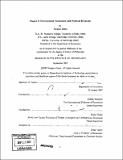| dc.contributor.advisor | Abhijit Banerjee and Esther Duflo. | en_US |
| dc.contributor.author | Datta, Saugato | en_US |
| dc.contributor.other | Massachusetts Institute of Technology. Dept. of Economics. | en_US |
| dc.date.accessioned | 2008-05-19T16:11:17Z | |
| dc.date.available | 2008-05-19T16:11:17Z | |
| dc.date.copyright | 2007 | en_US |
| dc.date.issued | 2007 | en_US |
| dc.identifier.uri | http://hdl.handle.net/1721.1/41714 | |
| dc.description | Thesis (Ph. D.)--Massachusetts Institute of Technology, Dept. of Economics, 2007. | en_US |
| dc.description | Includes bibliographical references. | en_US |
| dc.description.abstract | This thesis is a collection of three empirical essays on issues in economic development, with a focus ,on political economy and the labor market in India. Chapter 1] analyzes the effect of television coverage on political voice by examining the functioning of Question Hour, a forum for political discussion in India's Parliament, which is intended to foster government accountability to the people by allowing Members of Parliament (MPs) to raise questions about issues of concern to the electorate which the Government must answer. I use an unusual source of variation in the telecast status of Question Hour, made possible by the fact that it was only shown on television every other week, to assess what effect television had. I find that MPs did not become more likely to represent the concerns of the voters in their constituency. I argue that the evidence is consistent with party establishments exercising greater control on the participation of their MPs when Question Hour was televised than they otherwise did. Chapter 2 studies caste and religion in India's new economy sectors - IT (software) and IT-enabled services (call-centers) - by sending fictitious resumes in response to job openings in and around Delhi, India advertised in major city papers and online job sites. We find evidence of discrimination against Other Backward Classes (OBCs) and Scheduled Castes (SCs) in the call-center industry but no corresponding results for these or any other groups (including Muslims) in software jobs. We do however find that having a higher-quality resume helps SC applicants in software jobs the most, and OBCs not at all. We argue that the evidence for SCs is consistent with predictions from theories of statistical discrimination. | en_US |
| dc.description.abstract | (cont.) Chapter 3 asks whether there is empirical evidence of differential treatment by gender in India's Civil Service by following the careers of 1457 civil servants in India from the time they were recruited to the time they reached the fifth of seven levels within the Civil Service hierarchy. I compile and use a newly-collected data set made up of employment records for all entrants into the Indian Administrative Service, or IAS, between the years 1971 and 1984. Using the individual's rank at entry as a measure of initial quality, I compare the career progress of men and women in each quartile of the rank distribution for each entering cohort, and find that women in the lowest rank quartile take significantly longer than similarly-ranked men (as well as than higher-ranked men and women) to be promoted to level 5 of the civil service hierarchy, which I argue is evidence of statistical discrimination against women in the Indian civil service. | en_US |
| dc.description.statementofresponsibility | by Saugato Datta. | en_US |
| dc.format.extent | 118, [6] leaves | en_US |
| dc.language.iso | eng | en_US |
| dc.publisher | Massachusetts Institute of Technology | en_US |
| dc.rights | M.I.T. theses are protected by
copyright. They may be viewed from this source for any purpose, but
reproduction or distribution in any format is prohibited without written
permission. See provided URL for inquiries about permission. | en_US |
| dc.rights.uri | http://dspace.mit.edu/handle/1721.1/7582 | en_US |
| dc.subject | Economics. | en_US |
| dc.title | Essays in development economics and political economy | en_US |
| dc.type | Thesis | en_US |
| dc.description.degree | Ph.D. | en_US |
| dc.contributor.department | Massachusetts Institute of Technology. Department of Economics | |
| dc.identifier.oclc | 222290773 | en_US |
